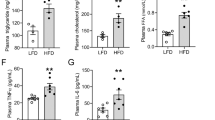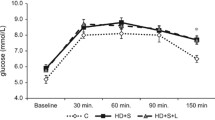Abstract
Background
Obesity is a serious health problem associated with the pathogenesis of various metabolic diseases. Nitric Oxide (NO) plays an important role in kidney function and altered NO levels have been associated with the pathogenesis of obesity. Therefore, we aimed to study whether an early stage of obesity contributes with progression of renal failure through further NO impairment.
Methods
Male C57BL/6 mice were fed with a high-fat diet (HFD) or a normal diet (ND) during 2 weeks. All mice underwent either sham surgery (sham) or 5/6 nephrectomy (Np). One group of HFD Np mice was treated with antioxidants plus L-arginine. Kidney damage parameters were assessed and eNOS metabolism was evaluated.
Results
Mice on a HFD increased body weight, eNOS protein and mRNA expression, and radical oxygen species (ROS). Urine nitrites excretion, urine volume, and plasma BH4 were decreased. In HFD mice, 5/6 Np further increased BH2 and urine protein concentration, ROS levels, and eNOS mRNA expression. The decrease in BH4 plasma levels and urine nitrites excretion was accentuated. NO synthesis stimulation with the antioxidants + L-arginine treatment prevented all these changes.
Conclusions
The early changes in NO metabolism are associated with an early stage of obesity. This effect on NO potentiates kidney damage development.




Similar content being viewed by others
References
Rahmouni K, Correia ML, Haynes WG, Mark AL (2005) Obesity-associated hypertension: new insights into mechanisms. Hypertension 45:9–14
Galassi A, Reynolds K, He J (2006) Metabolic syndrome and risk of cardiovascular disease: a meta-analysis. Am J Med 119:812–819
Pyörälä M, Miettinen H, Laakso M, Pyörälä K (1998) Hyperinsulinemia and the risk of stroke in healthy middle-aged men: the 22-year follow-up results of the Helsinki policemen study. Stroke 29:1860–1866
Iseki K, Ikemiya Y, Kinjo K, Inoue T, Iseki C, Takishita S (2004) Body mass index and the risk of development of end-stage renal disease in a screened cohort. Kidney Int 65:1870–1876
Ejerblad E, Fored M, Lindblad P, Fryzek J, McLaughlin JK, Nyren O (2006) Obesity and risk of chronic renal failure. J Am Soc Nephrol 17:1695–1702
Sun F, Tao Q, Zhan S (2010) Metabolic syndrome and the development of chronic kidney disease among 118 924 non-diabetic Taiwanese in a retrospective cohort. Nephrology 15:84–92
Henegar JR, Bigler SA, Henegar LK, Tyagi SC, Hall JE (2001) Functional and structural changes in the kidney in the early stages of obesity. J Am Soc Nephrol 12:1211–1217
Galili O, Versari D, Sattler KJ, Olson ML, Mannheim D, McConnell JP, Chade AR, Lerman LO, Lerman A (2007) Early experimental obesity is associated with coronary endothelial dysfunction and oxidative stress. Am J Physiol Heart Circ Physiol 292:H904–H911
Steinberg HO, Chaker H, Leaming R, Johnson A, Brechtel G, Baron AD (1996) Obesity/insulin resistance is associated with endothelial dysfunction implications for the syndrome of insulin resistance. J Clin Invest 97:2601–2610
Keogh JB, Grieger JA, Noakes M, Clifton PM (2005) Flow-mediated dilatation is impaired by a high-saturated fat diet but not by a high-carbohydrate diet. Arterioscler Thromb Vasc Biol 25:1274–1279
Martins MA, Catta-Preta M, Mandarim-de-Lacerda CA, Aguila MB, Brunini TC, Mendes-Ribeiro AC (2010) High fat diets modulate nitric oxide biosynthesis and antioxidant defence in red blood cells from C57BL/6 mice. Arch Biochem Biophys 499:56–61
Baylis C (2008) Nitric oxide deficiency in chronic kidney disease. Am J Physiol Renal Physiol 294:F1–F9
Chander V, Chopra K (2006) Protective effect of nitric oxide pathway in resveratrol renal ischemia-reperfusion injury in rats. Arch Med Res 37:19–26
Arellano-Mendoza MG, Castillo-Henkel C, Medina-Santillan R, Jarillo Luna RA, Robles HV, Romo E, Rios A, Escalante B (2008) Kidney damage after renal ablation is worsened in endothelial nitric oxide synthase (-/-) mice and improved by combined administration of l-arginine and antioxidants. Nephrology 13:218–227
Sanchez PL, Salgado LM, Ferreri NR, Escalante B (1999) Effects of cyclooxygenase-2 inhibition on renal function after renal ablation. Hypertension 34:848–853
Bradford MM (1976) A rapid and sensitive method for the quantization of microgram quantities of protein utilizing the principle of protein dye binding. Anal Biochem 72:248–254
Arellano-Mendoza MG, Vargas-Robles H, Del Valle-Mondragon L, Rios A, Escalante B (2011) Prevention of renal injury and endothelial dysfunction by chronic l-arginine and antioxidant treatment. Ren Fail 33:47–53
Livak KJ, Schmittgen TD (2001) Analysis of relative gene expression data using real-time quantitative PCR and the 2[−Delta Delta C(T)] method. Methods 25:402–408
Lin S, Thomas TC, Storlien LH, Huang XF (2000) Development of high fat diet-induced obesity and leptin resistance in C57Bl/6 J mice. Int J Obes Relat Metab Disord 24:639–646
Winzell MS, Ahrén B (2004) The high-fat diet-fed mouse: a model for studying mechanisms and treatment of impaired glucose tolerance and type 2 diabetes. Diabetes 53:S215–S219
Deji N, Kume S, Araki S, Soumura M, Sugimoto T, Isshiki K, Chin-Kanasaki M, Sakaguchi M, Koya D, Haneda M, Kashiwagi A, Uzu T (2009) Structural and functional changes in the kidneys of high-fat diet-induced obese mice. Am J Physiol Renal Physiol 296:F118–F126
National Cholesterol Education Program (NCEP) Expert Panel on Detection, Evaluation, and Treatment of High Blood Cholesterol in Adults (Adult Treatment Panel III) (2002) Third report of the National cholesterol education program (NCEP) expert panel on detection, evaluation, and treatment of high blood cholesterol in adults (Adult Treatment Panel III) final report. Circulation 106:3143–3421
Gretz N, Waldherr R, Strauch M (1993) The remnant kidney model. In: Gretz N, Strauch N (eds) Experimental and genetic rat models of chronic renal failure. Karger, Basel, pp 1–28
Dobrian AD, Davies MJ, Schriver SD, Lauterio TJ, Prewitt RL (2001) Oxidative stress in a rat model of obesity-induced hypertension. Hypertension 37:554–560
Weinberg JM (2006) Lipotoxicity. Kidney Int 70:1560–1566
Korda M, Kubant R, Patton S, Malinski T (2008) Leptin-induced endothelial dysfunction in obesity. Am J Physiol Heart Circ Physiol 295:H1514–H1521
Lin S, Thomas TC, Storlien LH, Huang XF (2000) Development of high fat diet-induced obesity and leptin resistance in C57B1/6 J mice. Intern J Obes 24:639–646
Avogaro A, de Kreutzenberg SV (2005) Mechanisms of endothelial dysfunction in obesity. Clin Chim Acta 360:9–26
Pryor WA, Squadrito GL (1995) The chemistry of peroxynitrite: a product from the reaction of nitric oxide with superoxide. Am J Physiol 268:L699–L722
Landmesser U, Dikalov S et al (2003) Oxidation of tetrahydrobiopterin leads to uncoupling of endothelial cell nitric oxide synthase in hypertension. J Clin Invest. 111:1201–1209
Grumbach IM, Chen W, Mertens SA, Harrison DG (2005) A negative feedback mechanism involving nitric oxide and nuclear factor κ-B modulates endothelial nitric oxide synthase transcription. J Mol Cell Cardiol 39:595–603
Herrera M, Garvin JL (2005) Recent advances in the regulation of nitric oxide in the kidney. Hypertension 45:1062–1067
Codoñer-Franch P, Valls-Bellés V, Arilla-Codoñer A, Alonso-Iglesias E (2011) Oxidant mechanisms in childhood obesity: the link between inflammation and oxidative stress. Transl Res 158:369–384
Vincent HK, Taylor AG (2006) Biomarkers and potential mechanisms of obesity-induced oxidant stress in humans. Int J Obes 30:400–418
Garcia-Diaz DF, Campion J, Milagro FI, Boque N, Moreno-Aliaga MJ, Martinez JA (2010) Vitamin C inhibits leptin secretion and some glucose/lipid metabolic pathways in primary rat adipocytes. J Mol Endocrinol 45:33–43
Huang A, Vita JA, Venema RC, Keaney JF Jr (2000) Ascorbic acid enhances endothelial nitric-oxide synthase activity by increasing intracellular tetrahydrobiopterin. J Biol Chem 275:17399–17406
Conflict of interest
We declare that we have no conflict of interest.
Author information
Authors and Affiliations
Corresponding author
Rights and permissions
About this article
Cite this article
Gámez-Méndez, A.M., Vargas-Robles, H., Arellano-Mendoza, M. et al. Early stage of obesity potentiates nitric oxide reduction during the development of renal failure. J Nephrol 27, 281–287 (2014). https://doi.org/10.1007/s40620-013-0029-9
Received:
Accepted:
Published:
Issue Date:
DOI: https://doi.org/10.1007/s40620-013-0029-9




